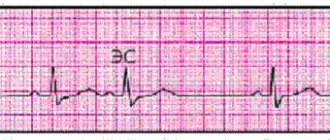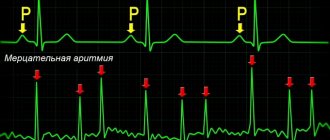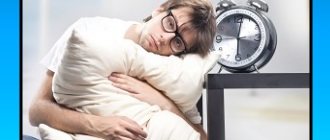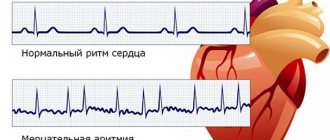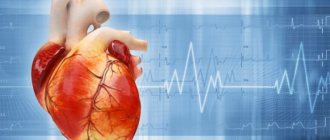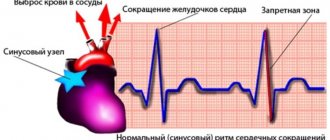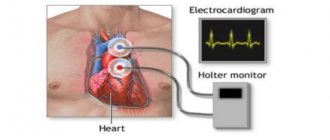Make an appointment by phone: +7 (343) 355-56-57
+7
- About the disease
- Cost of services
- Sign up
- About the disease
- Prices
- Sign up
Atrial fibrillation (AF)
is the most common rhythm disorder. It is registered everywhere and occurs in almost all age groups, but the frequency of its occurrence increases with each decade of life.
If you consult a doctor in a timely manner, correctly selected treatment and the patient follows all the doctor’s orders, the prognosis for this disease is quite favorable and the patient’s quality of life does not suffer significantly.
This applies to patients of all age groups, including the elderly.
Normally, the human heart has a conducting system. It is similar to electrical wiring and its function is to conduct impulses from the sinus node located in the left atrium to the heart muscle, causing it to contract. With atrial fibrillation, the function of one “power source” (sinus node) is taken over by multiple arrhythmic foci in the atrium and the heart contracts chaotically. That is why this arrhythmia is also called delirium cordis (delirium of the heart).
These arrhythmic foci can be quite small and multiple, and then this form of AF is called atrial fibrillation
(from Latin fibrillatio - small contractions, trembling). With larger and more organized foci of arrhythmia, they speak of atrial flutter (reminiscent of the flutter of a bird or butterfly wing). Atrial fibrillation is always chaotic and absolutely arrhythmic contractions of the heart. Atrial flutter can be either regular or irregular in shape. In the first case, the rhythm is correct, but in the second, it is as chaotic as in atrial fibrillation. These forms of MA can be distinguished only by ECG. However, the methods of diagnosis and treatment, as well as prevention of these forms of the disease, are the same. Although with atrial flutter there is a greater effect from surgical treatment methods.
Like any disease, MA has its own course. It begins, as a rule, with a suddenly developing episode (paroxysm), which can end as suddenly as it began.
In this case, restoration of normal (sinus) rhythm can occur both spontaneously (on its own) and with the help of special medications - antiarrhythmic drugs.
The further course of this disease is completely unpredictable. After the first paroxysm, this ari often lasts for many years, and then it can appear at the most unexpected moment. Or, conversely, after the first episode, rhythm disturbances become more and more frequent. And, as a rule, with the increase in frequency and lengthening of paroxysms of MA, it gradually turns into a permanent form, that is, it settles in the patient’s heart forever.
In some cases, when paroxysms are repeated quite often and exhaust the patient, the transition of the arrhythmia to a permanent form brings him relief, because each episode of failure and recovery leads to complications.
In any case, you can live with this arrhythmia, you just need to master the basic principles of managing it. However, it should be understood that it is almost impossible to cure this disease once and for all, like many other diseases (bronchial asthma, diabetes mellitus, hypertension, coronary heart disease, etc.) - you can only coexist with MA, control its symptoms and prevent the development of complications.
A special cohort consists of patients with frequent relapses of AF. In this case, we are talking about either incorrect treatment (the patient does not take the medications, or takes them in an insufficient dose, and the problem can be solved with the help of an arrhythmologist). However, in some cases, an increase in paroxysmal AF is a natural course of the disease, indicating that the paroxysmal form of AF will soon become permanent. This process can be interrupted using surgical treatments.
Atrial fibrillation is usually divided into the following forms:
1.According to development mechanisms;
A. atrial fibrillation B. atrial flutter:
- correct form
- irregular shape
2.By heart rate (HR);
- tachysystolic (heart rate 90-100 per minute and above)
- bradysystolic (heart rate 60 per minute and below)
- normosystolic (heart rate 60-80 per minute)
3. According to the frequency of occurrence of arrhythmia;
- paroxysmal (occurring periodically, each such paroxysm (episode of arrhythmia) lasts no more than 7 days and often goes away on its own, sometimes requiring the use of special medications to restore the rhythm)
- persistent (lasts more than 7 days and requires active rhythm restoration)
- permanent (lasts more than a year and an attempt may be made to restore the rhythm)
- constant (lasts more than a year, rhythm restoration is not indicated due to its ineffectiveness)
Naturally, all these forms are combined with each other. For example, the diagnosis may indicate a paroxysmal tachysystolic form of atrial fibrillation, an increase in paroxysms.
Types of arrhythmia
- Tachycardia . An increase in heart rate is considered normal during physical activity. If your heart beats more than 80 beats per minute at rest, you should see a doctor.
- Bradycardia . Heart rate may slow down during sleep. A regular decrease in the rate of contractions in combination with poor health may indicate a progressive pathology.
- Extrasystole . Rhythm disturbances are characterized by premature contraction of the heart. This condition often develops against a background of stress and psycho-emotional tension.
- Atrial fibrillation . Characterized by chaotic contraction of the myocardium.
- Paroxysmal arrhythmia . The condition is accompanied by attacks of heartbeat at a rate of more than 140 (usually closer to 200) beats per minute.
The main reasons for the development of MA are:
1. diseases of the cardiovascular system:
- hypertonic disease
- heart defects
- previous heart attacks
- previous myocarditis (inflammatory heart disease)
- toxic (alcoholic) cardiomyopathy
2. diseases of the bronchopulmonary system:
- bronchial asthma
- chronic obstructive pulmonary disease
- pneumonia
3. diseases of the gastrointestinal tract:
- peptic ulcer
- erosive gastroduodenitis
- HP infection (Helicobacter pylori gastroduodenitis)
- cholelithiasis
- chronic pancreatitis
- inflammatory bowel diseases
4.endocrine disorders:
- thyroid disease (thyrotoxicosis)
- diabetes
5. infections (ARVI, influenza, sepsis)
6. bad habits:
- alcohol abuse
- drug use
- heavy smoking
7.violation of the work and rest regime (work without days off and holidays, frequent business trips)
8.exacerbation of any concomitant pathology
9.oncological diseases, especially after courses of radiation and chemotherapy
10. combination of factors
AF can be detected when recording an electrocardiogram, when measuring blood pressure (the “arrhythmia” icon flashes on the tonometer screen), or the patient himself feels an unusual heartbeat.
If AF is detected, the patient should immediately contact an arrhythmologist or cardiologist. He will be offered an outpatient examination or, if necessary, hospitalization.
The optimal time to seek medical help is within 48 hours from the moment of the development of MA, since in this case it is possible to restore the rhythm as quickly, effectively and safely as possible.
In the latter case, artificial restoration of sinus rhythm with the help of drugs is called drug cardioversion. In the case when the heart rhythm is restored using an electric current (defibrillator), we talk about electrical cardioversion
One way or another, any form of this disease needs treatment. The global cardiological community has long developed a strategy for the management of such patients and identified the main goals of treating patients with atrial fibrillation.
Causes and symptoms
Most often, heart rhythm disturbances are diagnosed in patients with risk factors such as:
- coronary heart disease - myocardial infarction, hypertension, angina pectoris;
- congenital pathology, trauma, heart surgery;
- diabetes mellitus, thyroid dysfunction, obesity;
- old age - over 65 years old.
Causes of heart problems, regardless of age, also include: smoking, taking drugs and certain medications, frequent consumption of alcohol and caffeinated drinks - coffee, strong tea, energy drinks.
How you feel with atrial fibrillation largely depends on the heart rate per minute:
- pulse exceeds 90 beats - anxiety, increased sweating, tremors of the limbs appear;
- pulse is less than 60 beats - the brain does not have enough oxygen, so pre-syncope and fainting, cloudiness of consciousness, and increased fatigue occur.
- The pulse is normal - disorders can be asymptomatic, detected by chance or during a routine examination. The danger lies in the absence of warning factors - a person cannot control the consequences, such as blood clots or stroke, because he does not know about the disease.
Common signs of the disease include dizziness, shortness of breath, pain in the chest or shoulder blades, and a feeling of heartbeat. But it cannot be said that these symptoms only signal arrhythmia or heart disease. To make an accurate diagnosis, diagnostics is needed.
These include:
1. Rhythm control/pulse rate control
If rhythm disturbances occur more than once or twice a year, constant use of antiarrhythmic drugs is necessary.
Tactics to actively restore and maintain normal (sinus) rhythm using AAP are called rhythm control tactics. It is preferable in those patients with paroxysmal, permanent and persistent forms of the disease who lead an active lifestyle and do not have solid concomitant pathology. With fairly frequent, prolonged episodes of AF, ongoing planned antiarrhythmic therapy is also mandatory. Often, an increase in paroxysms is a natural course of the disease. But in some cases, this form of MA is caused by improper treatment, when the patient takes medications in insufficient doses or is not treated at all. It is the arrhythmologist who is called upon to select the treatment regimen that will help the patient cope with the disease. If it is unsuccessful, the patient may be recommended to consult a cardiac surgeon - arrhythmologist for surgical treatment of AF.
If this arrhythmia becomes permanent, active rhythm restoration is not indicated due to ineffectiveness. Under the influence of a long-term arrhythmia, the structure and function of the heart change and it “gets used” to living with it; it is no longer possible. In such patients, pulse control tactics are used, that is, with the help of medications, a heart rate that is comfortable for the patient is achieved. But no active attempts are made to restore the rhythm.
The following are currently used as antiarrhythmic drugs:
- beta blockers (metoprolol, bisoprolol, carvedilol)
- propafenone
- amiodarone
- sotahexal
- allapinin
- digoxin
- drug combination
2.Prevention of complications:
prevention of stroke and thromboembolism
With AF, there is no single, coordinated ejection of blood from the heart; some of the blood stagnates in its chambers and, in the form of blood clots, can enter the vessels. Most often, the blood vessels of the brain are affected and a stroke develops.
In order to prevent it, drugs that affect blood clotting are prescribed - warfarin, rivaroxaban, dabigatran, apixaban, which reliably (more than 90%) protect against stroke.
While taking these drugs, the patient should monitor for bleeding and monitor the complete blood count and creatinine quarterly. (when taking rivaroxaban, dabigatran and apixaban)., or test the INR (international normalized ratio) at least once a month when taking warfarin. This is necessary in order to correctly calculate the dose of the drug and monitor its safety.
Acetylsalicylic acid (aspirin, cardiomagnyl, thromboass) is not routinely used for the prevention of thromboembolism, since the degree of protection against venous thrombosis when used is only 25%.
prevention of heart failure
Heart failure (HF)
– a complication of many heart diseases, including AF. This condition is caused by the lack of full pumping function of the heart, as a result of which the liquid part of the blood stagnates in the tissues and organs, which is manifested by shortness of breath and edema.
For the prevention and treatment of heart failure, ACE inhibitors (enalapril, lisinopril, perindopril, etc.), veroshpiron (eplerenone), and diuretics (torasemide, furosemide, hypothiazide) are used.
3. Surgical treatment is used if there is no effect from medications and is carried out in specialized cardiac surgery clinics.
Types of surgical treatment of MA:
- implantation of a pacemaker for bradyform MA
- radiofrequency ablation of the pulmonary veins and other arrhythmogenic areas
- with paroxysmal tachyform of atrial fibrillation and flutter
Surgery for arrhythmias in general and AF in particular is the “last cartridge” used when drug therapy is unsuccessful.
After surgical treatment, in order to prevent recurrence of arrhythmia, patients are prescribed planned antiarrhythmic therapy.
Thus, treatment of atrial fibrillation is a way of life that involves the patient “working on himself.” And an arrhythmologist helps him with this.
A patient with MA should avoid colds, lead a healthy lifestyle, get rid of bad habits and avoid factors leading to its development, and strictly follow all the recommendations of his doctor. The doctor will help you choose an individual treatment regimen and recommend what to do if a recurrence of arrhythmia develops, and will also promptly refer you to a cardiac surgeon - arrhythmologist, if indicated.
It is important to understand that the selection of antiarrhythmic therapy takes some time, requires repeated examinations by a doctor and a number of dynamic studies (general clinical tests, study of thyroid hormone levels, cardiac ultrasound and Holter ECG monitoring, electrocardiogram registration) and this should be treated with understanding. In some cases, it is necessary to replace one drug with another.
Living with atrial fibrillation is not an easy process and it is very important that the patient feels supported and helped by the doctor. We are happy to help you with this and are ready to offer follow-up programs for a cardiologist, arrhythmologist and cardiac surgeon in our clinic.
Diagnostic methods
To determine atrial fibrillation, a comprehensive examination of the heart and related organs is performed, and the patient’s physical condition is also analyzed.
The examination includes:
- electro- and echocardiography,
- daily or multi-day ECG monitoring,
- Ultrasound of the thyroid gland and hormone analysis,
- clinical and biochemical blood test,
- determination of potassium and magnesium levels,
- lipid profile,
- physical stress testing.
It is convenient to undergo complex diagnostics in a specialized cardiac center: you don’t have to waste energy, time and additional money on visiting doctors in different clinics in your city. The result of the diagnosis should be a detailed plan for further treatment.
Where is treatment for arrhythmia performed and how much does it cost?
Comprehensive treatment of cardiac arrhythmia in St. Petersburg is carried out in a medical clinic. The treatment plan is drawn up after a comprehensive examination of the patient and confirmation of the diagnosis. Treatment includes classical conservative methods, which in most cases help stabilize the patient's condition. If the effectiveness is unsatisfactory or there is a high risk of complications, the patient is referred to a cardiac surgeon. To make an appointment with a cardiologist at Tauras-Med, call or fill out the feedback form on the website.
What sensations occur during arrhythmia?
The leading symptoms are irregular, slow or accelerated heart rate, a feeling of interruptions in the heart's function and a feeling of fading. Heart rhythm disturbances cause panic attacks, dizziness, changes in consciousness, sweating and pale skin. Arrhythmia can be constant or manifest itself in attacks lasting from several minutes to several days.
The most common type (atrial fibrillation) is characterized by the following symptoms: chaotic contractions, which are accompanied by sweating, shortness of breath, weakness, trembling, and frequent urination.
